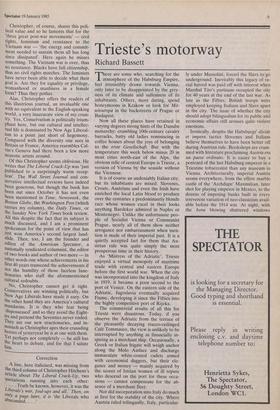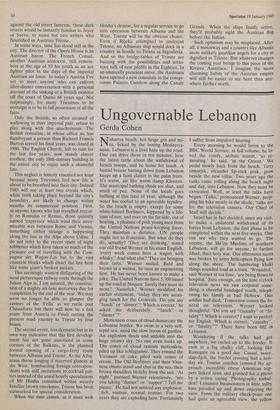Trieste's motorway
Richard Bassett
'There are some who, searching for the 1 atmosphere of the Habsburg Empire, feel irresistibly drawn towards Vienna, only later to be disappointed by the grey- ness of its climate and sullenness of its inhabitants. Others, more daring, spend honeymoons in Krakow or look for Mit- teleuropa in the backstreets of Prague or Budapest.
Now all these places have retained in varying degrees strong hints of the Danube monarchy: crumbling 10th-century cavalry barracks, batty old ladies reminiscing in coffee houses about the joys of belonging to the erste Gesellschaft. But with the temperature this week below minus 20 in most cities north-east of the Alps, the obvious relic of central Europe is Trieste, a version of Vienna by the seaside without the Viennese.
It is of course an undeniably Italian city, but its inhabitants are mixed: Slovenes, Croats, Austrians and even the Irish have enriched the local Latin blood to produce over the centuries a predominantly blonde race whose women excel in their looks anything Baedeker admired in Naples or Montenegro. Unlike the unfortunate peo- ple of Socialist Vienna or Communist Prague, nearly all of them show neither arrogance nor embarrassment when men- tion is made of their imperial past. It is a quietly accepted fact for them that Au- strian rule was quite simply the most prosperous time in their history.
As 'Mistress of the Adriatic', Trieste enjoyed a virtual monopoly of maritime trade with central and eastern Europe before the first world war. When the city was incorporated into the kingdom of Italy in 1919, it became a poor second to the port of Venice. On the eastern side of the Adriatic, Jugoslavia eventually acquired Fiume, developing it since the Fifties into the highly competitive port of Rijeka.
The commercial results of all this for Trieste were disastrous. Today, if you observe the Adriatic from the terrace of the pleasantly decaying stucco-ceilinged Cafe Tommaseo, the view is unlikely to be interrupted by anything as financially in- spiring as a merchant ship. Occasionally, a Greek or Italian frigate will weigh anchor along the Molo Audace and discharge immaculate white-coated cadets armed with ceremonial daggers, but their ele- gance and money — mainly acquired by the scores of Istrian women of ill repute who descend on the port for these occa- sions — cannot compensate for the ab- sence of a merchant fleet.
Nor did incorporation into Italy do much at first for the stability of the city. Where Austria ruled trilingually, Italy, particular- ly under Mussolini, forced the Slays to go underground. Inevitably this legacy of ra- cial hatred was paid off with interest when Marshal Tito's partisans occupied the city for 40 years at the end of the last war. As late as the Fifties, British troops were employed keeping Italians and Slays apart in the city. The issue of whether the city should adopt bilingualism for its public and economic affairs still arouses quite violent emotions.
Ironically, despite the Habsburgs' divide et impera tactics Slovenes and Italians believe themselves to have been better off during Austrian rule. Bookshops are cram- med with literature proclaiming Austria era un paese ordinato. It is easier to buy a postcard of the last Habsburg emperor in a Triestine tobacconist than any museum in Vienna. Architecturally, imperial Austria seems everywhere, from the effete marble castle of the 'Archdupe' Maximilian, later shot for playing emperor in Mexico, to the dozens of imposing banks built in every irreverent variation of neo-classicism avail- able before the 1914 war. At night, with the bora blowing shuttered windows against the old street lanterns, these dark streets would be instantly familiar to Joyce or Svevo, to name but two writers who flourished in Austrian Trieste.
In some ways, time has stood still in the city. The director of the Opera House is an Austrian baron. The French Consul, another Austrian aristocrat, still remem- bers at the age of 93 his youth as an ace fighter pilot in the days of the imperial Austrian air force. In today's Austria I've yet to meet anyone who can enliven after-dinner conversation with a personal account of the sinking of a British monitor off the coast of Duino 68 years ago. Not surprisingly, for many Triestines to be nostalgic is to be in. full possession of all the facts.
Only the British, so often accused of wallowing in thier imperial past, refuse to play along with this anachronism. The British consulate, in whose office no less flamboyant a person than Richard Francis Burton served his final years, was closed in 1980. The English Church, left to ruin for the last five years, now stands almost roofless, the only 18th-century building in the entire city to enjoy such a shameful fate.
This neglect is bitterly resented not least because many Triestines feel new life is about to be breathed into their city. Indeed 1985 will see at least two events which, while both taking place beyond the city's boundary, are likely to change within months its commercial position. First, as anyone knows who has travelled recent- ly on Romulus or Remus, those quaintly named 'expresses' which wind their inter- minable way between Rome and Vienna, something rather strange is happening along the line in the Alps above Udine. I do not refer to the recent spate of night robberies which have taken so much of the pleasure out of travelling with the Com- pagnie des Wagon-Liu but to the vast concrete blocks which dwarf the line here like some giant's broken molars.
This seemingly wanton disfiguring of the most picturesque railway route through the Julian Alps is, I am assured, the construc- tion of a mighty six-lane motorway due for completion by the end of the year. We may soon no longer be able to glimpse the ravines of the 'Fella' as we rattle past Chiusaforte but there will now be a fast route from Austria to Friuli cutting the present road journey to Trieste by four hours.
The second event, less dramatic but in its own way indicative that this first develop- ment has not gone unnoticed in some corners of the Balkans, is the planned formal opening of a cargo-ferry route between Albania and Trieste. As the Alba- nians throw longing if reserved glances at the West, bombarding foreign correspon- dents with stiff invitations to cocktail par- ties instead of the usual hourly speculations of Mr Hoxha contained within wearily familiar brown envelopes, Trieste has been earmarked for special consideration.
When the time comes, as it must with Hoxha's demise, for a regular service to go into operation between Albania and the West, Trieste will be the obvious choice: Even if Rijeka attempted to undercut Trieste, no Albanian ship would dock in a country as hostile to Tirana as Jugoslavia. And so the bridge-tables of Trieste are buzzing with the possibilities and sotto- voce talk of new profits in the Eighties. In an unusually prescient move, the Austrians have opened a new consulate in the conspi- cuous Palazzo Cambon along the Canale Grande. When the ships finally arrive, they'll probably sight the Austrian flag before the Italian.
Such optimism may be misplaced. After all, a motorway and a country like Albania seem unlikely guardian angels for a city as dignified as Trieste. But whatever changes the coming year brings to this piece of the Riviera Austriaca, I imagine the more charming habits of the Austrian empire will still be easier to see here than any- where farther north.











































 Previous page
Previous page